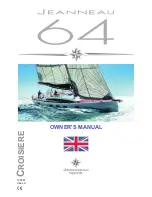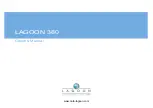
p. 6
Owners Manual
Many people would love to own and use a boat,
but are kept away from their dreams by fears they
would not be able to launch, operate and retrieve
a boat. This uncertainty is relieved with practice
and experience and you will soon gain confidence.
The following sections are designed to give you
the skills to become a more confident and aware
boat operator on protected waters.
FUELLING PROCEDURES
Internal Built-In Fuel Tank
If fuelling the boat whilst in the water, be sure it is
securely moored to the dock.
Turn off all electrical equipment including the
engine, appliances, lights etc.
Extinguish all cigarettes, cigars or other items that
may produce a spark or flame.
Through-deck fittings are provided for fuel tank
filling. Remove the cap and insert the fuel supply
nozzle, allowing the nozzle to maintain contact
with the fitting; this will prevent possible static
sparking.
If, when filling the tank, you can’t put fuel in at a
reasonable rate, check the fuel vent line to see that
it’s not kinked or blocked. If the problem persists
consult your dealer.
When you have finished fuelling, replace the
fill cap and wash off any fuel spillage.
Fuel up on your way to the water, not on your way
home or before you store your boat.
Allow for thermal expansion of the fuel on very hot
days. Do not over fill the fuel tank.
Our boats have many different fuel tanks to suit our
broad range. Some tanks are deeper than others.
Depending on the fuel tank depth and the length
of the fuel sender, the gauge may not give a true
indication of the amount of fuel remaining in the
tank when the gauge reads ‘empty’.
The first time the tank is filled, have someone fill
the tank slowly while watching the fuel gauge. As
soon as the gauge moves (and remains) at a point
above “empty” stop filling the tank and note the
amount of fuel registered at the bowser.
This is an indication of the fuel reserve in the tank.
Never assume there is enough reserve in the tank
to get home as the fuel gauge may read differently
while at sea due to attitude, lean or list of the boat.
Portable Fuel Tank
Remove the tank from the boat for filling.
If your outboard requires a petrol/oil mix, follow
the engine manual instructions for the proper
lubrication oil and petrol ratio mix.
Before placing the tank back in the boat, wash off
any spilled fuel.
Some portable tanks have vent screws which must
be open during engine operation.
ENGINE USE
The engine operating and maintenance manual
provided with your boat describes pre-start and
starting procedures. Modern engines are designed
to be started in a particular way. Read the starting
procedure for your engine carefully prior to
attempting operation.
Special Note: The following advantages and
disadvantages of a Lanyard Stop Switch should
be considered before electing to use such a
switch.
Spilt fuel may damage the paint work, the
plastic side pocket material and the carpet
on your vessel. If a fuel spill occurs insure it
is cleaned up immediately.
ATTENTION
!
Do not use fuels that incorporate any form
of alcohol or alcohol derivatives or ethanol.
Alcohol and ethanol’s may destroy marine
fuel system hoses and components, which
could lead to hazardous leaks, fire or
explosion.
ATTENTION
!
OPERATING







































